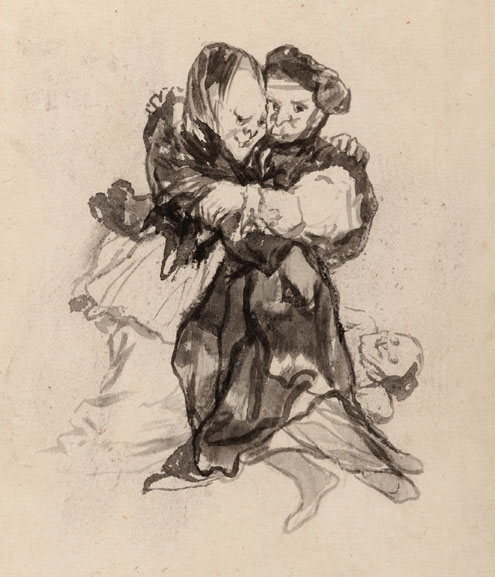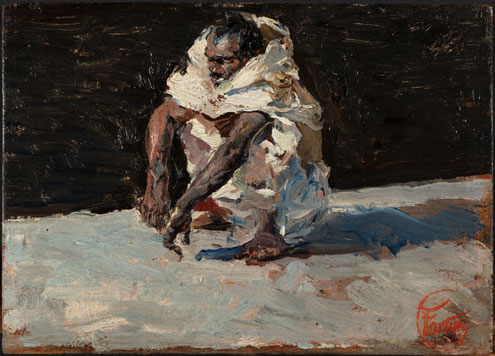Dallas, Texas (SMU) -- The Meadows Museum, SMU, has acquired two works that complement important aspects of its exceptional collection of Spanish art. A drawing by Francisco José de Goya y Lucientes (1746–1828), titled Visions (c. 1819–23), is the first Goya drawing to enter the Meadows collection, which already includes six of the artist’s paintings and important holdings of his prints, including first-edition sets of the Spanish master’s four print series. The Museum has also acquired Crouched Arab (c. 1871), an oil sketch by Mariano Fortuny y Marsal (1838–1874) that was used for a figure in the artist’s larger canvas Tribunal of the Alhambra (1871). Both works will be on view at the Meadows Museum this spring: the Fortuny sketch will join the Museum’s upcoming exhibition Fortuny: Friends and Followers opening on February 3 and the Goya drawing will be installed with a small selection of related works from the Museum’s permanent collection on April 30.

“We are thrilled to welcome these two creations into the Meadows collection, where they will contribute greatly to our mission as the leading center for Spanish art and its art historical scholarship in the Americas,” said Mark A. Roglaìn, the Linda P. and William A. Custard Director of the Meadows Museum. “Goya remains one of the most important artists of all time, and this drawing from one of his personal albums affirms his skill as a draftsman and endless imagination. Working some fifty years later, Fortuny was a gifted painter who helped spur interest in new styles of painting, and this painterly oil sketch gives insight into his talent, effortlessly reproducing with only a few brushstrokes the figure of this crouching man. I would like to thank The Meadows Foundation, Cyrena Nolan, and Jenny and Richard Mullen for their support of the acquisition of these two critical works.”
During his short life and career, Fortuny became an extremely popular and widely collected artist in both Europe and the United States. As the Meadows’ upcoming exhibition Fortuny: Friends and Followers (February 3–June 2, 2019) illuminates, Fortuny was an influential force on other artists of the time. He was known in particular for a proto-Impressionist style and, as a result of his travels throughout Europe and North Africa, for an interest in genre scenes depicting settings, objects, and figures from other countries and cultures, which Western audiences considered foreign or “exotic” at the time. Fortuny was also part of a changing approach to painting historical subjects, shifting the emphasis toward ornate details of a scene and the finery of the people in it.

The preparatory oil sketch Crouched Arab, like the subsequent finished work Tribunal of the Alhambra (Fundació Gala-Salvador Dalí, Figueres), reflects these changes in style and approach, with an emphasis on the power of setting. Perhaps painted during one of his trips to North Africa, Crouched Arab shows Fortuny’s skill as an artist capable of conjuring a scene and conveying a sense of feeling for the figures in it.
The acquisition is an important addition to the Meadows Museum’s collection, in particular its holdings of works by Fortuny. Unlike other examples of his paintings at the Meadows—including Beach at Portici (1874), the major painting Fortuny was working on at his death (acquired by the Meadows Museum in January 2018)—Crouched Arab becomes the first oil sketch by the artist in the collection, thereby expanding the range of artistic techniques in our holdings. The sketch remained in Fortuny’s studio when he died, until it was later auctioned in Paris by his widow; it was subsequently held by a series of collectors until being acquired by the Meadows.
Goya’s Visions, the first drawing by Goya to be added to the Meadows Museum’s collection, comes from one of the artist’s personal albums known as the “Witches and Old Women Album” or “Album D.” Visions is drawing number 10 of a total 23 in that album, and the name for the work comes from Goya’s own inscription, “Visiones,” faintly visible in graphite at the bottom of the sheet. The drawing depicts two elderly figures in what looks like an embrace—or is perhaps an attempt by one figure to pick the pocket of the other. As befits a personal journal where an artist might record or explore ideas, Goya’s drawing shows evidence of rapidly drawn lines, with an emphasis on the grotesque features of each figure, as well as their flowing garments and head coverings. At the same time, there is evidence that the artist worked intensely on the drawing, rotating the page to use different angles and erasing or scraping away ink to add to the effect. The result is an image that shows Goya’s skill as a draftsman as well as his ability to depict such figures with intensity.
Drawings such as this are rare, since personal albums by artists do not always survive beyond the artist’s death. In this case, the rarity of the work is enhanced by its distinguished provenance: After being owned by the artist’s son and grandson, it was owned by Federico de Madrazo y Kuntz (1815–1894), a well-known Spanish portrait painter whose work is also in the Meadows’ collection, and subsequently by the French writer Victor Hugo (1802–1885). The work has been in private collections for most of the 20th century, with occasional public display, such as in a 2015 exhibition at The Courtauld Gallery in London dedicated to Goya’s “Witches and Old Women Album.”
Support for the Museum’s purchase of the Goya drawing was provided by The Meadows Foundation, with additional support from Cyrena Nolan. The Meadows’ acquisition of the Fortuny oil sketch was made possible with funds donated by Jenny and Richard Mullen and friends of the Meadows Museum.
Photography by Kevin Todora.
About the Meadows Museum
The Meadows Museum is the leading U.S. institution focused on the study and presentation of the art of Spain. In 1962, Dallas businessman and philanthropist Algur H. Meadows donated his private collection of Spanish paintings, as well as funds to start a museum, to Southern Methodist University. The museum opened to the public in 1965, marking the first step in fulfilling Meadows’s vision to create “a small Prado for Texas.” Today, the Meadows is home to one of the largest and most comprehensive collections of Spanish art outside of Spain. The collection spans from the 10th to the 21st centuries and includes medieval objects, Renaissance and Baroque sculptures, and major paintings by Golden Age and modern masters.